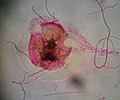A pycnidium (plural pycnidia) is an asexual fruiting body produced by mitosporic fungi, for instance in the order Sphaeropsidales (Deuteromycota, Coelomycetes)...
2 KB (229 words) - 01:50, 14 May 2024
of conidiomata, distinguished by their form, are: pycnidia (singular: pycnidium), which are flask-shaped, and acervuli (singular: acervulus), which have...
15 KB (1,777 words) - 23:53, 11 May 2024
top called perithecia (singular: perithecium), and pycnidia (singular: pycnidium), shaped like perithecia but without asci (an ascus is the structure that...
130 KB (14,225 words) - 16:44, 20 August 2024
in asexual sporocarps with different characteristics (e.g. acervulus, pycnidium, sporodochium). Some species of ascomycetes form their structures within...
54 KB (6,636 words) - 08:33, 6 September 2024
that it is a polycyclic disease, it can asexually produce conidia in a pycnidium which continually inoculates new hosts throughout the growing season,...
7 KB (944 words) - 16:05, 10 January 2024
Lichenoconium reichlingii Diederich 1986. Pycnidium with dark brown conidia. Photo: Paul Diederich....
9 KB (865 words) - 15:54, 9 May 2024
were made by Julius von Flotow (e.g. epithecium), Edmond Tulasne (e.g pycnidium), and William Nylander (e.g. pseudocyphella, thecium). Gustav Wilhelm...
221 KB (19,674 words) - 15:06, 6 September 2024
conidia-bearing structures such as a synnema, a sporodochium, an acervulus, or a pycnidium. conidiophore A specialized hypha bearing or consisting of conidiogenous...
151 KB (13,044 words) - 14:10, 26 August 2024
are Laurocerasi-brown in the proper exciple, hymenium and wall of the pycnidium, Bagliettoana-green in the hymenium and uppermost part of proper exciple...
3 KB (307 words) - 23:22, 2 January 2024
may grow anywhere on the pycnidium. Pycnidiospores are hyaline, oblong to ovoid, biguttulate, and sessile in the pycnidium; they ooze from ruptures or...
7 KB (838 words) - 01:28, 19 May 2024







